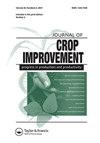Sustainable intensification under resource constraints: Estimating the heterogeneous effects of hybrid maize adoption in Nepal
IF 1
Q3 AGRONOMY
引用次数: 6
Abstract
ABSTRACT Managerial practices for farming-system intensification have received increased focus in research-and-development (R&D) initiatives. These technologies are proven to close the yield gaps in researcher-managed field trials and are recommended for farmer’s adoption. However, not all farmers have the technical, financial, and social capital to adopt and benefit from these recommended technologies. Is the current level of productivity enhancement achieved by smallholder system intensification sufficient to sustain rural livelihoods? To this end, the study assessed the impacts of hybrid maize (Zea mays L.) adoption on productivity and livelihoods in the mid-hill region of Nepal. Smallholders in the study region face severe shortages of labor, improved cultivars, and inorganic fertilizers, resulting in very low yields and profitability. We find that maize hybrid adoption increased crop productivity by 109%, making the crop profitable for smallholders and enhancing the per capita food expenditure by 20%. Nevertheless, these benefits were unevenly distributed: relatively small farms (≤0.3 ha) achieved greater gains in productivity and livelihood per land unit from hybrid maize adoption, but only larger farms (>0.3 ha) enjoyed the aggregate livelihood benefits of the technology. System intensification gains economic relevance because of the severe scarcity of resources, whereas the resource scarcity itself determines the economic relevance of system intensification, presenting a paradox. Increasing market access to material inputs did not significantly alter the observed patterns. More studies are required on the relationship between farm size and the livelihood impacts of sustainable intensification to facilitate R&D targeting and ensure inclusive development.资源约束下的可持续集约化:估计尼泊尔杂交玉米采用的异质效应
农业系统集约化的管理实践在研究与开发(R&D)计划中受到越来越多的关注。这些技术在研究人员管理的田间试验中被证明可以缩小产量差距,并被推荐给农民采用。然而,并非所有农民都具备采用这些推荐技术并从中受益的技术、财政和社会资本。目前小农系统集约化所取得的生产力提高水平是否足以维持农村生计?为此,本研究评估了杂交玉米(Zea mays L.)的采用对尼泊尔中部山区生产力和生计的影响。研究区域的小农面临劳动力、改良品种和无机肥料的严重短缺,导致产量和盈利能力非常低。我们发现,采用玉米杂交作物使作物产量提高了109%,使小农获利,并使人均粮食支出提高了20%。然而,这些效益分布不均:相对较小的农场(≤0.3公顷)通过采用杂交玉米获得了更大的生产力和单位土地生计收益,但只有较大的农场(≤0.3公顷)享受到了该技术带来的总体生计效益。制度集约化由于资源的严重稀缺性而获得经济相关性,而资源的稀缺性本身又决定了制度集约化的经济相关性,形成了一个悖论。增加物质投入的市场准入并没有显著改变观察到的模式。需要对农场规模与可持续集约化对生计的影响之间的关系进行更多的研究,以促进研发目标和确保包容性发展。
本文章由计算机程序翻译,如有差异,请以英文原文为准。
求助全文
约1分钟内获得全文
求助全文
来源期刊

Journal of Crop Improvement
Multiple-
CiteScore
3.30
自引率
7.70%
发文量
42
期刊介绍:
Journal of Crop Science and Biotechnology (JCSB) is a peer-reviewed international journal published four times a year. JCSB publishes novel and advanced original research articles on topics related to the production science of field crops and resource plants, including cropping systems, sustainable agriculture, environmental change, post-harvest management, biodiversity, crop improvement, and recent advances in physiology and molecular biology. Also covered are related subjects in a wide range of sciences such as the ecological and physiological aspects of crop production and genetic, breeding, and biotechnological approaches for crop improvement.
 求助内容:
求助内容: 应助结果提醒方式:
应助结果提醒方式:


